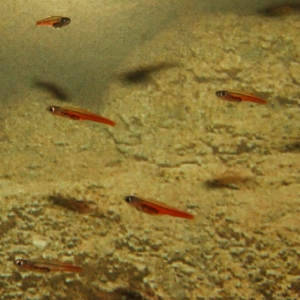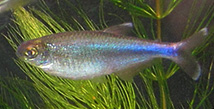
Characiformes is an order of ray-finned fish, comprising the characins and their allies. Grouped in 18 recognized families, more than 2000 different species are described, including the well-known piranha and tetras.

Characidae, the characids or characins, is a family of freshwater subtropical and tropical fish belonging to the order Characiformes. The name "characins" is an historical one, but scientists today tend to prefer "characids" to reflect their status as a, by and large, monophyletic group. To arrive there, this family has undergone much systematic and taxonomic change. Among those fishes remaining in the Characidae currently are the tetras, comprising the very similar genera Hemigrammus and Hyphessobrycon, as well as a few related forms, such as the cave and neon tetras. Fish of this family are important as food in several regions, and also constitute a large percentage of captive freshwater aquarium fish species.

The Anostomidae are a family of ray-finned fishes that belong to the order Characiformes. Closely related to the Chilodontidae and formerly included with them, the Anostomidae contain about 150 described species. Commonly known as anostomids, they are found in freshwater habitats from the Río Atrato in northernmost South America to warm-temperate central Argentina; they are of Amazon origin, with few found west of the Andes. Their scientific name approximately means "mouth on top", from Ancient Greek áno- (ἄνω) "up" + stóma (στόμᾶ) "mouth", in reference to the arrangement of these fishes' mouth opening.

Paedocypris is a genus of tiny cyprinid fish found in swamps and streams on the Southeast Asian islands of Borneo, Sumatra and Bintan.

Glandulocaudinae are a subfamily of tropical freshwater characin fish from Central and South America. In all species of this subfamily, a gland on their caudal fin is found almost exclusively in the males, which allows the release and pumping of pheromones; also, members of this subfamily have complex courtship behaviors which lead to insemination. The ecology and life history of these fish is complex yet little studied. Glandulocaudines are important as food fish for larger fish important for commercial and subsistence reasons.

Boehlkea fredcochui, also known as the Cochu's blue tetra is a species of characin. Its natural range is in the Amazon Basin. It is commonly kept as an aquarium fish.
Chrysobrycon is a genus of characins endemic to South America.

Gephyrocharax is a genus of characins found in South America, Trinidad in the Caribbean, and Panama.
Hysteronotus megalostomus is a species of characin endemic to Brazil where it is found in the upper São Francisco River basin. This species is the only member of the genus Hysteronotus.
Knodus is a genus of characins, small freshwater fish from South America.
Lepidocharax is a genus of characins endemic to the Doce, Paraguaçu and São Francisco basins in eastern Brazil. They are small fish, that reach up to 4 cm (1.6 in) in standard length.
Lophiobrycon weitzmani is a species of small characin endemic to Brazil, where it is found in the upper Paraná River basin. It is considered threatened by Brazil's Ministry of the Environment. This species is the only member of the genus Lophiobrycon, but it is closely related to Glandulocauda and Mimagoniates.
Pseudocorynopoma is a genus of characins from tropical South America.
Rhinopetitia is a genus of characins endemic to Brazil.
Trochilocharax ornatus is a species of characin endemic to Peru. This species is the only member of the genus Trochilocharax.
Xenurobrycon is a genus of characins from tropical South America.
Paedocypris carbunculus is a tiny species of cyprinid fish endemic to peat swamps and blackwater streams in Central Kalimantan, Borneo, Indonesia. It is the most recently described species of the three in the genus Paedocypris and it reaches up to 11.5 mm (0.45 in) in standard length. This shoaling species has been kept and bred for several generations in aquariums.

Carlastyanax aurocaudatus is a small species of freshwater fish in the family Characidae native to the Río Cauca in Colombia. It is the only member of the monotypic genus Carlastyanax, which was named in 1972 specifically for the species by Jacques Géry. Upon description, it was named Astyanax aurocaudatus by Carl H. Eigenmann. There has been debate concerning whether or not the genus should be recognized, but C. aurocaudatus is currently considered a valid species.

Astyanax biotae is a small species of freshwater fish native to various localities in Brazil. It primarily eats invertebrates, like copepods and aquatic fly larvae, and its diet also includes seeds, fruits, and filamentous algae. Its scales are largely silver, with a touch of yellow-brown on the back and a hint of blue on the sides. Like many species of Astyanax, it has a humeral spot, which is a blotch of pigmentation in the area above or around the pectoral fin.

Astyanax clavitaeniatus is a small species of freshwater fish native to various rivers in the Amazon basin. It is characterized by a club-shaped lateral stripe, which is where it gets its scientific name; "clava" means "club", and "taenia" means "stripe". It is a deep-bodied fish with a silvery base color, which is not uncommon for members of Astyanax. Its markings - including a humeral spot and two vertical brown bars - indicate that it is a part of a species complex centered around congener Astyanax bimaculatus.









